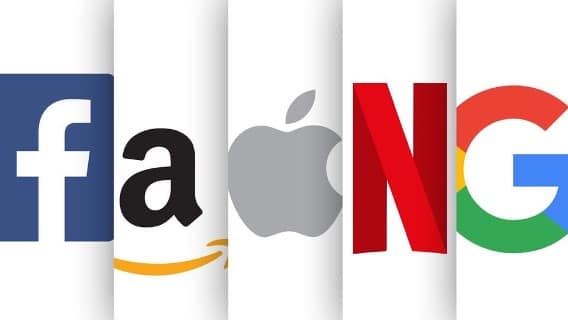FAANG stocks are reporting positive earnings so far in Q1 2023. Each holds a useful insight for long-term investing.

The FAANG stocks are a long-term investor’s ultimate quandary. All have seen huge growth and market dominance during the decade or so of ultraloose monetary policy; and as interest rates rise and the money supply contracts, all have experienced sizeable valuation contractions.
With market lows seen during Q4 2022 amid stickier-than-expected inflation seemingly baked into the US economy, these tech stocks needed to deliver a quarter of reassuring numbers — and most seem to have pulled this off.
As a caveat, the following does not constitute advice. Instead, it’s strongly held opinion on position investing.
NASDAQ 100: investor lessons from Q1 earnings
1. Alphabet (NASDAQ: GOOGL)
The Google and YouTube owner saw revenues come in 3% higher than a year ago, demonstrating the resilience and power of its search business — where it still dominates 90% of the market.
Further, YouTube saw subscription revenues increase, and Google Cloud turned a profit for the first time ever. $70 billion of share buybacks was also announced, far more than expected.
Key lesson: Microsoft’s OpenAI ChatGPT investment and growing TikTok competition does not mean that the king can be easily usurped.
2. Meta (NASDAQ: META)
Meta’s demise has been similarly oversold. Its ‘family of apps’ — Facebook, Instagram, and WhatsApp — boasts more than 3 billion monthly active users, and like Alphabet, revenue rose by 3% in the quarter.

CEO Mark Zuckerberg has promised a ‘year of efficiency,’ cutting thousands of jobs after facing competition from TikTok and Apple’s $10 billion hit to its revenue as a result of privacy changes. However, despite investing $3.99 billion into investor-hated Reality Labs, the AI and Metaverse focused department of the company — the share price rallied anyway.
Key lesson: Meta had a $300 billion market cap six months ago, meaning each MAU was valued at $100 by the market. This was overselling at its finest — and given AI developments, the Metaverse spending could eventually pay off when growth returns.
3. Amazon (NASDAQ: AMZN)
Amazon saw sales rise by 9% to $127.4 billion in the quarter, above analyst expectations and its own forecasts. Further, it generated a $3.2 billion profit — a far cry from the $3.8 billion loss of a year ago. Shares jumped as this was the strongest quarter since 2021 — and remember, this is the world’s largest e-commerce company.
Its advertising business grew by 23%, while AWS cloud revenue spiked by 16% to $21.35 billion. However, operating margin at AWS has fallen to 24% — its narrowest since 2017, a combination of inflation and firefighting competitors.
Key lesson: AWS controls 34% of the global cloud computing market share, more than its nearest two competitors combined. Even though growth is slowing, and costs are rising, this cornered market will prop up shares for some time.
4. Netflix (NASDAQ: NFLX)
Netflix shares fell 10% and have since recovered to stay flat since reporting earnings — with a mixed picture set of results. Netflix may have been the streaming pioneer, but the company now faces stiff competition from the likes of Disney+, HBO, and Amazon Prime. Unlike the other FAANG stocks, it does not have the same wide economic moat.

Revenue was up from $7.87 billion in Q1 2022 to $8.16 billion in Q1 2023, but this top line number could be about to take a hit despite adding 1.75 million subscribers in the quarter.
43% of its userbase — or 100 million households — share accounts. The company, which used to promote free password sharing, has cracked down hard in several test areas including Spain, where Kantar estimates it has already lost 1 million subscribers.
Key lesson: A US and ROW crackdown is coming later this year, and a toxic cocktail of competitors, inflation, piracy, and falling consumer spending could spell disaster.
5. Apple (NASDAQ: AAPL)
Apple reports earnings on 4 May. The world’s most valuable company is likely to be hit by slowing computer sales — down 30% globally this year —and cash-strapped customers making their iPhone last longer than they would in the past. Indeed, some analysts are expecting that Apple Mac computer sales will collapse by a whopping 40%.
Key lesson: Forecasters expect weak results, so much of this may be priced in. Apple tends to surprise analysts to the upside and shares are still a little distance from their record high.
Closing comments
The FAANG stocks grow faster when interest rates are low, and slower when they are high. US Federal Reserve Chair Jerome Powell has strongly cautioned that there will be no rate cuts this year, and that rates will indeed likely rise again. Meanwhile, forex and bond markets are pricing in a 50 basis point cut from the current level.
Markets are also pricing your favourite FAANG companies — if they’re wrong about interest rates, share price falls are inevitable. And if they’re right, interest rate cuts could herald the start of a recession, creating share price falls later on.
A soft landing for NASDAQ tech stocks requires a Sully Sullenburger — and given the tools at the Fed’s disposal, the best we have is Max Pruss.
Bursting the inflationary bubble may only be the first half of the story.
This article has been prepared for information purposes only by Charles Archer. It does not constitute advice, and no party accepts any liability for either accuracy or for investing decisions made using the information provided.
Further, it is not intended for distribution to, or use by, any person in any country or jurisdiction where such distribution or use would be contrary to local law or regulation.